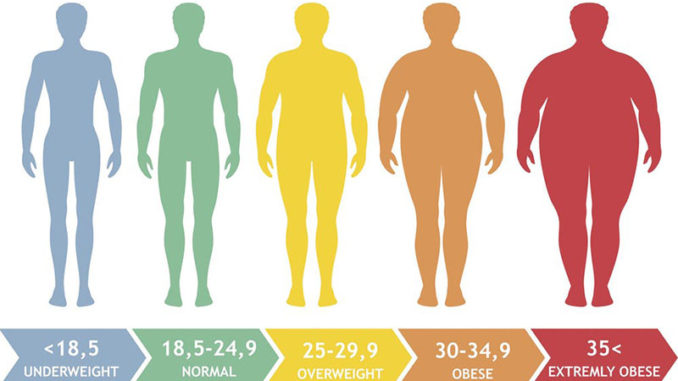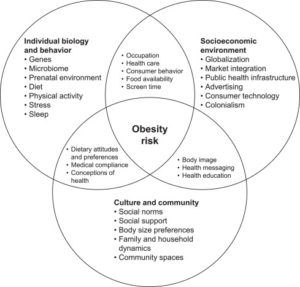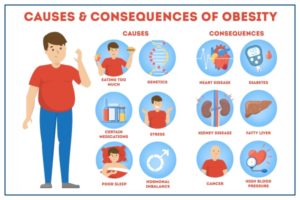
Table of Contents
What is Obesity?
- Obesity refers to abnormal or excessive fat accumulation in the body that possess risk to the health.
- Obesity is a complex, chronic illness that can lead to excessive body fat and, sometimes, poor health.
- Obesity is a complex medical problem that increases the risk of other diseases and health problems such as diabetes, heart disease, hypertension etc.
- According to the World Health Organization (WHO), obesity is a condition where a body mass index (BMI) over 30.
- WHO defines obesity for children and adults as follows:
- For children under five years of age: weight-for-height greater than 3 standard deviations above the WHO Child Growth Standards median.
- For children between 5-19 years of age: BMI-for-age greater than 2 standard deviations above the WHO Growth Reference median.
- For adults: BMI greater than or equal to 30.
- Obesity affects both adults and children and is a common, severe, and expensive chronic disease.
- Unhealthy body fat is obviously not a disease in and of itself. However, having too much extra body fat could change the way your body functions.
- These gradual changes could worsen with time and could have an adverse effect on one’s health.
- A person’s weight and height are computed using the body mass index (BMI) calculation to calculate their body size.
Key Facts
- The prevalence of obesity has nearly tripled worldwide since 1975.
- The prevalence of obesity has reached epidemic levels around the world and is a significant factor in the burden of chronic diseases and disability.
- Around 1.2 billion people worldwide are overweight, with at least 300 million of them obese.
- According to the World Health Organization, one of the top 10 health concerns that can be prevented is obesity.
- Disorders like hypertension, diabetes, hypercholesterolemia, and liver disease are all associated with obesity.
- In 2020, 39 million under-fives were overweight or obese.
Causes of Obesity
- Long-term consumption of more calories than the body expends through normal activity and exercise can result in obesity.
- These excess calories accumulate over time and lead to weight gain.
- However, it’s not always just about how many calories you consume and expend or how active you are.
- Although those are the actual causes of obesity, certain reasons are uncontrollable.
- The following are typical specific causes of obesity:
- Growing older, which can result in less muscle mass and a slower metabolism, making it easier to gain weight
- Genetics, which may have an impact on how your body burns food for energy and stores fat
- Not getting enough sleep, which can result in hormonal changes that makes feeling more hungry and crave specific high-calorie foods
- Due to the possibility that weight acquired during pregnancy may be difficult to reduce and eventually result in obesity
- Weight gain and obesity may also be caused by specific medical conditions. These consist of:
- A disorder known as polycystic ovarian syndrome (PCOS) that disrupts the balance of female reproductive hormones
- Overeating is a symptom of the rare disorder Prader-Willi syndrome, which is present at birth.
- High quantities of the stress hormone cortisol (which causes Cushing syndrome) in the body
- Underactive thyroid, or hypothyroidism, is a disorder in which the thyroid gland doesn’t generate enough of a number of essential hormones.
- Osteoarthritis (OA) and other painful disorders that might cause activity reduction
Risk factors of Obesity

Biological
- Gene
- Microbiome
- Diet
- Physical activity
- Sleep and stress
Socioeconomic environment
- Advertising
- Globalization
- Infrastructure
- Markets
Culture and community
- Social norms
- Social belief and support
- Body size
- Family and household dynamics
- Community spaces
- Body image
- Dietary attitude
Signs and Symptoms
- More body fat, particularly around the waist
- Breathing difficulty
- More perspiration than usual
- Snoring
- Difficulty in sleeping
- Skin problems caused by moisture accumulation in the folds
- Inability to carry out simple physical activities that were no problem before weight gain
- Fatigue, which can be mild to severe
- Back and joint pain in particular
- Low self-esteem, despair, humiliation, and social isolation are examples of mental health issues.
Diagnosis of Obesity
- A person’s weight in relation to their height is roughly calculated using their BMI.
- Additional, more precise methods of calculating body fat and body fat distribution include:
- Testing for skinfold thickness
- Comparisons of hips to waist ratio
- Screening procedures such MRIs, CT scans, and ultrasounds
- The following tests may be used to detect health risks associated with obesity:
- Blood tests to check cholesterol and glucose levels
- Testing for liver function
- Diabetes examination
- Thyroid exams
- Cardiac examinations, like an electrocardiogram (ECG or EKG)
- Risk for obesity-related diseases can also be accurately predicted by measuring the amount of fat around waist.
Complications/Consequences of Obesity

- Strokes and heart conditions: High blood pressure and excessive cholesterol levels, which are risk factors for heart disease and strokes, are likely to increase with obesity.
- Type 2 diabetes: Obesity may affect the body’s utilization of insulin to control blood sugar levels. Diabetes and insulin resistance are more likely to increase.
- Cancer of the uterus, cervix, endometrial, ovary, breast, colon, rectum, esophagus, liver, gallbladder, pancreas, kidney, and prostate are among the cancers that obesity may increase the risk.
- Digestive issues: Heartburn, gallbladder disorders, and liver issues are more likely to occur by obesity.
- Sleep apnea: Obesity increases the risk of sleep apnea, a potentially dangerous condition in which breathing regularly stops and resumes while asleep.
- Osteoarthritis: Obesity increases the strain on weight-bearing joints and promotes inflammatory processes in the body which might result in issues like osteoarthritis.
- Decreased quality of life including:
- Depression
- Discrimination/social isolation
- Shame and guilt
- Reduced work productivity
Prevention
- People should eat and drink in accordance with their nutritional needs, engage in regular exercise, and routinely check their weight to prevent overweight and obesity.
- Eat more foods with low energy densities and fewer foods with high energy densities.
- Alcohol, fast food, and sugary drinks should all be consumed less frequently.
- Exercise can be incorporated into daily tasks and as a leisure activity to prevent disease.
- The easiest way to accomplish this aim is to engage in more than two hours of weekly endurance-focused physical activity (using major muscle groups).
Treatment
Diet therapy
- A program of medical management should provide nutritional counseling (individual or in groups) in order to carry out dietary therapy.
- Patients should be advised to follow dietary regimens that, when followed over an extended period of time, result in an energy deficit without harming their health in order to lose weight.
Increased exercise
- Exercise for at least 150 minutes per week and weekly calorie expenditure between 1200 and 1800 kcal are necessary for effective weight loss.
- Weight loss is expected when big muscle groups are worked with the intensity moderate to high, and the exercise continued for long duration
Interventions for behavior modification
- The intervention can be carried out by certified non-psychotherapists and should focus primarily on modifying diet and exercise habits.
Weight reduction program
- Weight-loss regimens for obese people should be tailored to their unusual conditions and focused on the therapeutic objectives.
- The components of the fundamental program should be included in the weight loss plans (exercise, diet, and behavioral therapy)
Weight reducing drugs
- Only a basic program should be used in combination with drug therapy.
- Only orlistat may be taken into consideration.
- Patients needing orlistat medication should have a BMI greater than 28 kg/m2 and additional risk factors or co-morbidities, or a BMI less than 30 kg/m2 and less than 5% weight loss after six months on the basic program.
Long-term weight stabilization
- After successful weight loss, long-term therapies and consultations, including cognitive behavioral therapy, should be made available to assist weight stabilization.
Surgical intervention in extremely obese patients
- Surgical intervention should be taken into consideration for people who are very obese.
- In terms of body fat reduction, the improvement of obesity-related disorders, and the decrease of mortality risk, surgical treatment is more effective than conservative treatment.
WHO Response on Obesity
- “WHO Global Strategy on Diet, Physical Activity and Health” describes the actions needed to support healthy diets and regular physical activity.
- The WHO global strategy is adopted by the World Health Assembly in 2004 and recognized again in 2011.
- States are committed to reduce one-third premature mortality from NCDs through prevention and treatment by 2030.
- The “Global action plan on physical activity 2018–2030: more active people for a healthier world” provides effective and feasible policy actions to increase physical activity globally.
- WHO published new guidelines on physical activity, sedentary behavior and sleep in children under five years of age were launched in 2019.
- World Health Assembly welcomed the report of the Commission on Ending Childhood Obesity (2016) and its 6 recommendations to address the obesogenic environment and critical periods in the life course to tackle childhood obesity.
References and For More Information
https://www.who.int/news-room/fact-sheets/detail/obesity-and-overweight
https://www.mayoclinic.org/diseases-conditions/obesity/symptoms-causes/syc-20375742
https://www.who.int/news-room/fact-sheets/detail/obesity-and-overweight
https://www.cdc.gov/obesity/basics/causes.html
https://www.nhs.uk/conditions/obesity/
https://www.nhlbi.nih.gov/health/overweight-and-obesity
https://my.clevelandclinic.org/health/diseases/11209-weight-control-and-obesity
https://www.healthline.com/health/obesity#risk-factors
https://www.ncbi.nlm.nih.gov/pmc/articles/PMC3026124/
https://jissn.biomedcentral.com/articles/10.1186/1550-2783-2-2-4
https://www.ncbi.nlm.nih.gov/pmc/articles/PMC4233761/
https://www.thelancet.com/journals/lanwpc/article/PIIS2666-6065%2820%2930040-7/fulltext